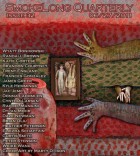You are the intended recipient of a steganographic message, the kind of secret of which only sender and addressee are aware. A steganographic message, as you are privileged to know, is quite different from a merely encrypted one: while an elaborate encryption might baffle an expert, an expert would not even recognize a steganographic message when he saw one. It would float past him, undetected, igniting no spark in his usually intrepid eye. A shopping list, perhaps, or a flier advertising the services of one Madame ______, reader of palms. The discarded draft of a résumé. A photograph of a family dressed entirely in white, posed on the beach in anticipation of the coming winter’s Christmas card. A ticket stub to a recent concert given by a singer in vogue two generations ago. A business card on which someone has blacked out the embossed name and written an entirely new one, leaving all the other information intact. The fine print on a credit card application. A coupon offering a discount for first-time visitors to the offices of twin dentists in a newly renovated strip mall. A tattoo on the forearm of a woman who will not tell her life’s story. Fingernail clippings, arranged in a decorative box, as if for sentimental reasons. A report card for a child who has nothing remarkable to show for herself, whether good or bad. A pair of DNA reports for a couple whose mutual faith in science has led them to investigate their joint genetic destiny. A bus schedule, folded crosswise. The blinking screen of an out-of-date cell phone, donated to an outfit that promises to assist soldiers overseas. A scratch-ticket for a state lottery designed as a pun on the word “windfall.” The multitude of braids in the hair of the boy placed beside you by his mother on a crowded subway, each plait tipped with a bead of a different color. The grease-stained envelope on which a man has scribbled the license plate of a woman who has side-swiped him in traffic, as well as transliterations of the Lithuanian words for “house,” “delicious,” “beautiful,” “honor,” “future” and “tree nuts.” The detached back cover of a library book, to which several small sheets of paper are still glued, stamped with due dates that span seventeen years. The hum of the leaf-blower your neighbor to the left purchased at the yard sale of your neighbor to the right. The results, tallied in pencil on a yellow legal pad, of a game with five opponents and no apparent winner. The intermittent beeping of a cashier’s scanning device as she processes the groceries of the man who asked if he might step ahead of you in line, giving no reason for his haste, but asking in a tone that, also for no apparent reason, you could not refuse. The markings on the carpet walkway outside a hotel in a distant city where you can’t afford to stay, the ones that seem to slice into the pilings at highly irregular intervals. The footprints left in the sidewalk’s first dusting of snow by a meter-maid’s angular tango, danced to no audible music and with no visible partner. Watch closely: steganography cannot, by definition, flaunt its own encryption. The code you’re meant to crack has no time for games. It will flit into your life suddenly, unannounced, and then move on.
You Alone Are Privy to this Vision

art by Dave Reale


 The core workshop of SmokeLong Fitness is all in writing, so you can take part from anywhere at anytime. We are excited about creating a supportive, consistent and structured environment for flash writers to work on their craft in a community. We are thrilled and proud to say that our workshop participants have won, placed, or been listed in every major flash competition. Community works.
The core workshop of SmokeLong Fitness is all in writing, so you can take part from anywhere at anytime. We are excited about creating a supportive, consistent and structured environment for flash writers to work on their craft in a community. We are thrilled and proud to say that our workshop participants have won, placed, or been listed in every major flash competition. Community works.